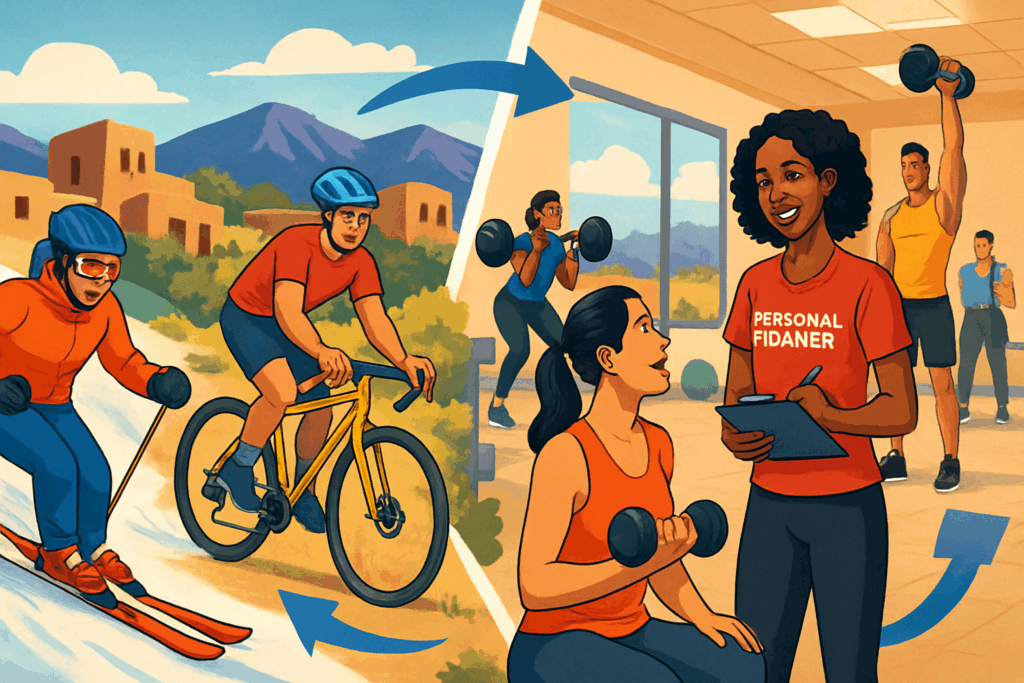
Why Fun Activities Alone Aren’t a Complete Plan
It’s incredibly common—especially in a place like Santa Fe—to fall in love with a sport or activity and hope that’s all it takes to stay fit. As a career personal trainer (who’s a bit obsessed with skiing), the truth is unavoidable: no recreational activity covers all the bases for balanced strength, lasting health, and injury prevention. Enjoyment matters, but a full, healthy routine is much more than simply repeating what’s fun.
Reason #1—It’s Not Tailored to Your Needs
Leaping into any activity without an honest, personalized assessment is like driving cross-country with no map—odds are, you’ll miss a turn. Fitness assessments cut through the guesswork by setting objective baselines for mobility, strength, performance, and function. This step clarifies weaknesses or imbalances that a favorite activity (skiing, cycling, tennis, yoga, etc.) won’t always reveal—until something hurts.
Skipping assessment and using generic programs means risking hidden compensations or movement faults. The repercussions? Years of subtle wear, faulty joint loading, or muscle imbalances that may only show up years later as pain or dysfunction.
Personalization is critical. A well-structured routine should take into account prior injuries, current needs, and realistic progression, mixing and matching with the seasons and the body’s feedback. No online class, YouTube video, or off-the-shelf program should ever replace that.
Reason #2—Endorphins Are Great, But Don’t Ignore Wear and Tear
Endorphin highs make activity rewarding—blood flows, mood lifts, and life feels better during and after the run or ride. But those good vibes can blind anyone to underlying risks. Without variety and structured maintenance, even the best-loved routine can mask nagging imbalances.
The classic example: runner’s knee (patellofemoral syndrome). Repetitive knee flexion in running, cycling, or skiing can slowly grind down cartilage, but early on it’s just a mild ache—easy to ignore over the endorphin buzz. Repetition amplifies movement faults; just because it doesn’t hurt now, doesn’t mean it won’t become a problem in the future.
Reason #3—Overuse, Stagnation, and Missed Recovery
Recreational routines by default tend to repeat the same movement patterns—and the body adapts quickly. Muscles, ligaments, and joints need stimulus in all planes of motion to be balanced, strong, and resilient. It’s not just about variety to avoid boredom (although that matters!)—it’s also about challenging your body beyond its favorite ruts.
A stale program leads to plateaus: the body stops responding, and improvements halt. More importantly, focusing on a single activity increases odds of overuse injuries, as some tissues absorb all the stress while others don’t get the chance to recover or strengthen.
Rest and cross-training are crucial. Mixing strength, mobility, stability, flexibility, and recovery (including sleep!) helps build lasting results, keeping both body and mind engaged. Overtraining or lack of recovery can disrupt hormone balance, rundown the immune system, and set the stage for burnout or injury.
How a Balanced Fitness Routine Sets You Up for Success
When you rotate foundational strength, mobility, assessment-based corrective work, and meaningful recovery days, you prepare your body for both your favorite hobbies and whatever real life throws your way. A great personal training program does three things:
- Assesses where you are today (not where you wish you were)
- Designs routines that fill your unique gaps, not just ride on strengths or preferences
- Progresses you with variety, intensity, and recovery until you’re stronger, more confident, and resistant to injury
If you want to keep doing what you love for decades—without the slow creep of pain or injury—stop relying on one activity and start building a smarter, more holistically designed plan.
Ready for a comprehensive assessment, custom plan, or advice about optimizing your favorite activities?
https://www.solcorefitness.com/free-consultation/
Get more information @

Leave a Reply